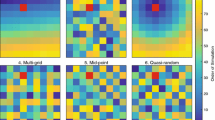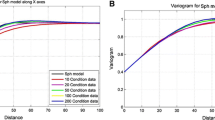Abstract
Simulated annealing (SA) is being increasingly used for the generation of stochastic models of spatial phenomena because of its flexibility to integrate data of diverse types and scales. The major shortcoming of SA is the extensive CPU requirements. We present a perturbation mechanism that significantly improves the CPU speed. Two conventional perturbation mechanisms are to (1) randomly select two locations and swap their attribute values, or (2) visit a randomly selected location and draw a new value from the global histogram. The proposed perturbation mechanism is a modification of option 2: each candidate value is drawn from a local conditional distribution built with a template of kriging weights rather than from the global distribution. This results in accepting more perturbations and in perturbations that improve the variogram reproduction for short scale lags. We document the new method, the increased convergence speed, and the improved variogram reproduction. Implementation details of the method such as the size of the local neighborhood are considered.
Similar content being viewed by others
REFERENCES
Datta-Gupta, A., Lake, L. W., and Pope, G. A., 1995, Characterizing heterogeneous permeability media with spatial statistics and tracer data using sequential simulation annealing: Math. Geology, v. 27,no. 6, p. 763–787.
Deutsch, C. V., 1994, Algorithmically-defined random function models, in Dimitrakopoulos, R., ed., Geostatistics for the next century: Kluwer, Dordrecht, Holland, p. 422–435.
Deutsch, C. V., and Cockerham, P. W., 1994, Practical considerations in the application of simulated annealing of stochastic simulation: Math. Geology, v. 26,no. 1, p. 67–82.
Deutsch, C. V., and Journel, A. G., 1992, GSLIB: Geostatistical software library and user's guide: Oxford University Press, New York, 340 p.
Farmer, C. L., 1992, Numerical rocks, in King, P. R., ed., The mathematical generation of reservoir geology: Clarendon Press, Oxford.
Geman, S., and Geman, D., 1984, Stochastic relaxation, Gibbs distributions, and the Bayesian restoration of images: IEEE Trans. Pattern Anal. Mach. Intell., PAMI-6, no. 6, p. 721–741.
Journel, A. G., and Deutsch, C. V., 1993, Entropy and spatial disorder: Math. Geology, v. 25,no. 3, p. 329–355.
Kirkpatrick, S., Gelatt, C. D., Jr., and Vecchi, M. P., 1983, Optimization by simulated annealing: Science, v. 220,no. 4598, p. 671–680.
Metropolis, N., Rosenbluth, A., Rosenbluth, M., Teller, A., and Teller, E., 1953, Equation of state calculations by fast computing machines: J. Chem. Phys., v. 21,no. 6, p. 1087–1092.
Srivastava, R. M., 1994, An overview of stochastic methods for reservoir characterization, in Stochastic modeling and geostatistics: Principles, methods, and case studies: Am. Assoc. Pet. Geologists, Tulsa, OK, 379 p.
Author information
Authors and Affiliations
Rights and permissions
About this article
Cite this article
Deutsch, C.V., Wen, X.H. An Improved Perturbation Mechanism for Simulated Annealing Simulation. Mathematical Geology 30, 801–816 (1998). https://doi.org/10.1023/A:1021722508504
Issue Date:
DOI: https://doi.org/10.1023/A:1021722508504




